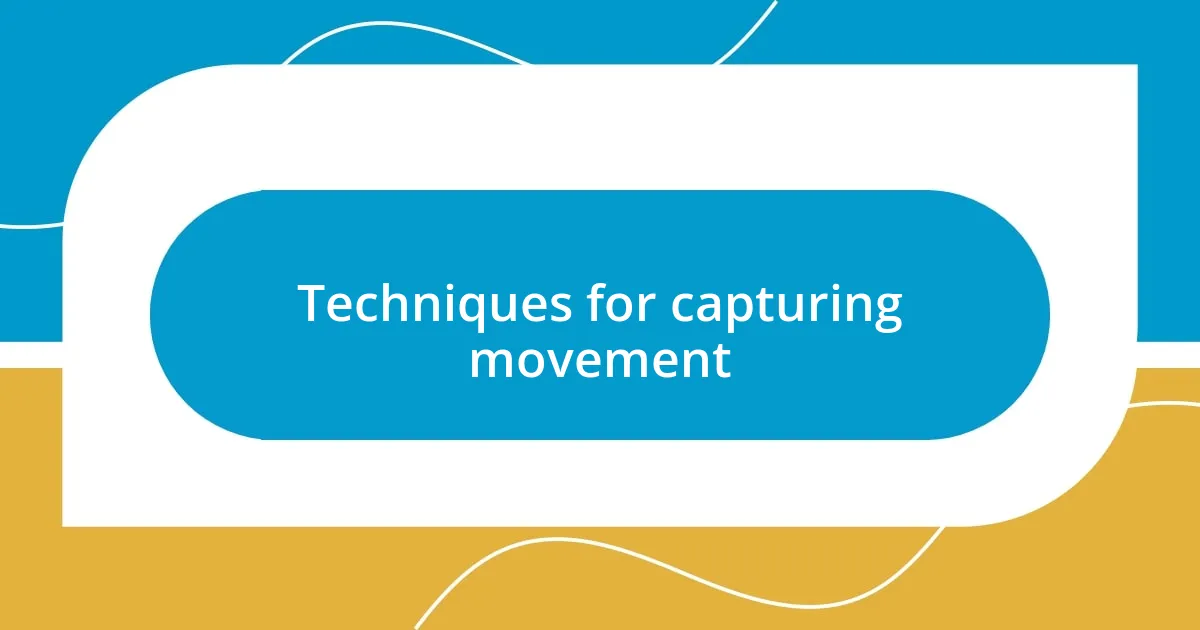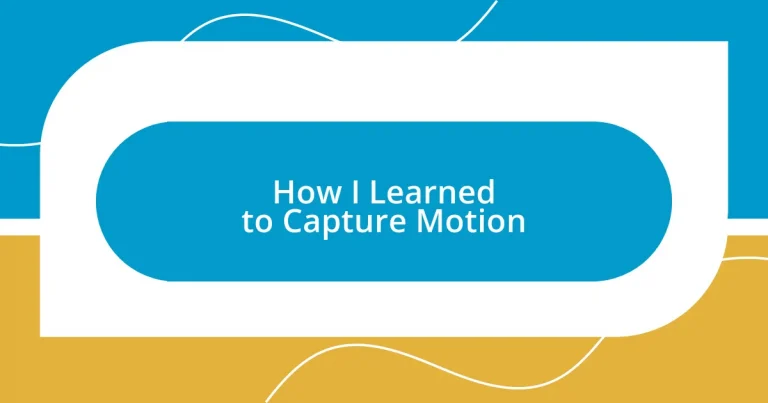Key takeaways:
- Understanding motion in photography involves mastering shutter speed, composition, and camera settings to effectively convey energy and movement.
- Techniques such as panning, burst mode, and strategic lighting enhance the portrayal of movement in dynamic shots.
- Post-processing, including color grading and cropping, plays a vital role in refining motion images and reinforcing the desired narrative.
- Building a personal motion style requires focusing on emotion, experimenting with different perspectives, and embracing spontaneity in capturing moments.

Understanding motion in photography
Understanding motion in photography goes beyond simply showing movement; it’s about capturing the essence of action. I remember the first time I attempted to photograph a running athlete. I was overwhelmed by the blur of their legs and the sweat flying in every direction. This experience made me realize that the challenge isn’t just in freezing a moment, but in portraying the energy and dynamism of that very instant. Have you ever felt that rush when you see a perfect shot come together?
As I experimented further, I discovered the importance of shutter speed in depicting motion. A slow shutter speed, for instance, creates a beautiful blur that communicates speed, while a fast shutter speed can freeze a moment in striking clarity. I found this out during a sunset cycling shoot, where my choice between the two created entirely different feelings in the images. It felt like painting with light, each choice telling its own story. Wouldn’t it be fascinating to think about how the same scene could evoke varied emotions based on your technical choices?
Additionally, the angle and composition play significant roles in understanding motion. I often wander off the beaten path, searching for unique perspectives that showcase movement in a way that feels alive. During one particular shoot at a bustling market, I crouched low and shot through the crowd, successfully capturing the rhythm of life unfolding around me. That moment reinforced the idea that sometimes, it’s not just the subject, but how and where you choose to frame it that brings the motion to life. Don’t you agree that perspective can transform an ordinary moment into an extraordinary story?

Choosing the right camera settings
When it comes to choosing the right camera settings for motion photography, I quickly realized that there’s no one-size-fits-all approach. Each shoot is different, and understanding how ISO, aperture, and shutter speed work together is crucial. For instance, during a vibrant street performance, I found myself adjusting the ISO to capture the energy of the dancers while ensuring the colors remained vivid. It was thrilling to see how my decisions directly influenced the final image.
Here’s a quick guideline to help you navigate these settings:
- Shutter Speed: Use a fast shutter speed (1/500 sec or faster) to freeze action, or a slower speed (1/30 sec or slower) to convey movement.
- ISO: Adjust the ISO based on lighting conditions—higher for low light, lower for bright scenes, while managing noise.
- Aperture: A wider aperture (like f/2.8) lets more light in and can create a shallow depth of field, isolating your subject, whereas a narrower aperture (like f/8) encompasses more of the scene in focus, which can be great for action shots in context.
I recall feeling nervous yet exhilarated when I tried shooting a motorcycle race. I started with a fast shutter speed to catch the bikes clearly, but as I experimented with slower settings, I was amazed at how the blurred backgrounds conveyed a sense of speed. It was a tangible reminder that the right settings can truly transform a visual narrative.

Techniques for capturing movement
Capturing movement effectively involves several techniques, each one adding a unique flavor to your images. One technique that stands out for me is panning. I remember my first attempt at panning while photographing a skateboarder. By following the subject with my camera and using a slower shutter speed, I was able to create a sharp image of the skater against a beautifully blurred background. This technique not only emphasizes speed but also adds a dynamic quality to the composition. Have you ever tried panning? It’s a thrilling way to showcase movement!
Another technique that has greatly impacted my photography is the use of burst mode. When I attended a lively dance event, I utilized burst mode to capture a sequence of movements all at once. The rapid succession of shots allowed me to select the perfect frame where the dancers were at their most expressive. It felt like tapping into a mini-action movie—the adrenaline was palpable as I clicked away, and each shot promised a different story to tell. Do you find burst mode to be a game changer for capturing fleeting moments?
Lastly, I cannot emphasize the importance of lighting when it comes to movement photography. I vividly recall an early morning shoot with joggers in the park. The soft, golden glow of the sunrise infused the whole scene with vitality. It taught me how lighting can enhance the feeling of movement—a well-placed light source can add drama to a fast-paced moment. Have you ever experienced how the perfect light can elevate an image?
| Technique | Overview |
|---|---|
| Panning | Following a moving subject while using a slower shutter speed to create a blurred background, emphasizing speed and dynamism. |
| Burst Mode | Taking multiple shots in rapid succession to capture a series of movements, allowing you to select the most expressive frame. |
| Lighting | Using natural or artificial light to enhance movement, creating drama and energy in the shot. |

Composing dynamic shots effectively
Composing dynamic shots effectively requires a keen eye for the relationship between movement and framing. I often think about how the position of the subject in my frame can dramatically alter the story I’m trying to tell. One memorable instance was at a local soccer game; I positioned myself to capture the player breaking away from a defender. The interplay of their movements created a powerful tension in the image that felt almost palpable. Isn’t it amazing how the right angle can elevate a moment?
Another important aspect I’ve learned is the use of leading lines to guide the viewer’s eye through the composition. During a bustling street fair, I noticed how the booths formed natural lines that drew attention to the performers. By framing my shot to incorporate these lines, I was able to create a sense of movement that directed the viewer’s gaze seamlessly across the image. Have you tried incorporating leading lines in your shots? It’s a simple trick that can add depth and dynamism.
Finally, don’t underestimate the role of negative space in your compositions. One afternoon, I captured a dancer leaping against an expansive backdrop, which allowed her powerful movement to stand out. This space not only emphasized her grace but also created an emotional resonance, evoking a sense of freedom. How do you feel about leaving space in your images? Personally, I find that it invites viewers to engage with the movement more thoughtfully, allowing their imagination to fill in the gaps.

Post-processing motion images
Post-processing motion images can truly elevate your photography. Recently, while editing a series of skateboard shots, I experimented with techniques like selective blur and contrast adjustments. Adding a bit of motion blur to the wheels gave an even greater sense of speed, while adjusting the contrast highlighted the vibrant graffiti in the background. It felt like bringing a static image to life. Have you ever considered how a few subtle tweaks in editing can transform your shots?
One fascinating aspect I’ve discovered is the importance of color grading. While working on images from a recent dance performance, I played around with warmer tones to evoke the energy and vibrancy of the evening. I was amazed at how changing the hue made the dancers appear more expressive and the environment more electric. Does color grading resonate with you? It can breathe new life into motion images, overwhelming me with the desired emotion just by shifting a few sliders.
Furthermore, cropping can be a powerful post-processing tool, often overlooked. After capturing a thrilling moment during a race, I cropped the image tightly around the runner, eliminating distractions. This choice focused the viewer’s attention on the movement and raw emotion of the runner’s determination. Isn’t it interesting how a simple crop can amplify the narrative? Each decision in post-processing should feel like a deliberate step toward reinforcing the story you want your image to tell.

Exploring different motion capture styles
Exploring different motion capture styles has been a journey filled with discovery. I remember the first time I tried panning to capture a cyclist racing past me. As I followed the motion, I was thrilled to see how the blurred background contrasted sharply with the crisp focus on the cyclist, creating a dynamic feel. Isn’t it fascinating how motion can be visually interpreted in so many ways?
Then there’s the beauty of freeze-frame action, which I experimented with during a local parkour event. Capturing a moment of a practitioner mid-air, frozen in time, brought out the intensity of the movement. It was almost like catching a breath in the middle of a chaotic performance. Have you felt the excitement of that split second where anything can happen? It really helps to convey energy and determination in ways that smooth motion can’t.
Finally, I delved into time-lapse photography to showcase movement over time, such as the changing shadows of an urban landscape. Watching the scene evolve from dusk till dawn reminded me how motion isn’t just about the immediate action but also about its transformation. I often ponder whether we appreciate the slow shifts in movement as much as the quick bursts. This style, to me, added a deeper layer of storytelling that revealed the passage of time in a way that felt contemplative and mesmerizing.

Building a personal motion style
Building a personal motion style has been an enriching experience for me. One practice that truly resonated was harnessing the emotion behind the movement. During a recent concert shoot, I found that focusing on the performers’ facial expressions had an incredible effect. It wasn’t just about capturing their physical actions; it was about conveying the passion and energy of the moment. Have you ever considered the emotional story behind the motion? That connection can redefine your approach to photography.
Another key element in developing my personal style was experimenting with different angles and perspectives. I remember setting up for a soccer match and deciding to get down low to the ground. This gave a unique view of players sprinting towards me, their feet kicking up dirt and grass. The raw energy was palpable. Isn’t it captivating how a shift in your viewpoint can transform the narrative? Finding that signature angle became essential in my quest to express individual motion styles.
I also embraced spontaneity in my photographic journey. One memorable day at a community festival, I caught an impromptu dance-off between friends. Instead of meticulously planning my shots, I let instinct take over. This resulted in a series of dynamic images that exuded joy and exhilaration. Can you imagine how freeing it felt to let go of rigid planning? That day taught me that sometimes, the best moments arise when we allow ourselves to be participants in the movement we’re capturing rather than mere observers.














